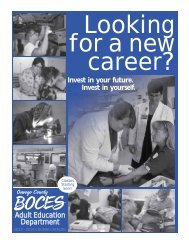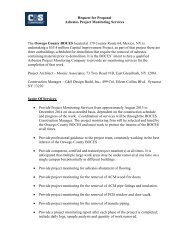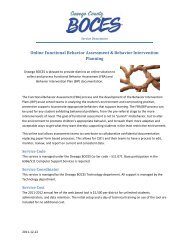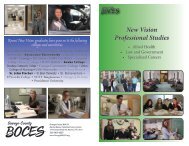Functional Behavior Assessment and Behavior Intervention Plans ...
Functional Behavior Assessment and Behavior Intervention Plans ...
Functional Behavior Assessment and Behavior Intervention Plans ...
Create successful ePaper yourself
Turn your PDF publications into a flip-book with our unique Google optimized e-Paper software.
Skills<br />
group situations<br />
**structured <strong>and</strong><br />
unstructured<br />
situations<br />
Sample<br />
determinations<br />
ATTACHMENTS<br />
E<br />
VI. DEVELOP A FUNCTIONAL HYPOTHESIS<br />
Using the information that emerges from data analysis, the team develops a hypothesis statement<br />
regarding the likely function(s) of the student behavior. The hypothesis statement can then be<br />
used to predict the social/environmental conditions (the context) within which the behavior is<br />
most likely to occur. Only when the function(s) of the behavior is (are) known is it possible for<br />
the team to establish an effective behavioral intervention <strong>and</strong> support plan. The hypothesis<br />
statement is a concise summary of information collected during the assessment phase, a<br />
statement that explains or represents a "best guess" regarding the reason(s) for the behavior. A<br />
well-written hypothesis statement gives clear direction to members who are responsible for<br />
developing a behavior intervention plan. Here are a few examples:<br />
o<br />
o<br />
o<br />
Charles disrupts reading class by swearing at the teacher when he is asked to read aloud.<br />
He is most likely to disrupt the class if he has not had breakfast or if there was a problem<br />
at the bus stop. Charles stops swearing when he is told to leave the group.<br />
When she does not get what she wants from her peers, Trish calls them names <strong>and</strong> hits<br />
them until they give in to her dem<strong>and</strong>s.<br />
Juan verbally threatens the teacher when he is given a math assignment that he sees as too<br />
lengthy <strong>and</strong> too difficult, but stops when he is told to find something else to do.<br />
VI. POSITIVE PREVENTIVE STRATEGIES<br />
Determine the student’s strengths, <strong>and</strong> known reinforces in order to target specific<br />
alternative/replacement behaviors. Effective behavior programs are based on the idea that an<br />
early response to a problem leads to better outcomes for students <strong>and</strong> teachers. The FBA will<br />
give educators practical <strong>and</strong> specific strategies to build successful positive, preventive programs<br />
in schools.<br />
What positive behaviors, activities <strong>and</strong> or roles could replace the problem behaviors<br />
<strong>and</strong> still serve the same function for the child?<br />
Replacement behaviors may include (e.g., communicative alternatives that provide an immediate<br />
mechanism for ones. An intervention plan should target specific skills <strong>and</strong> what will be taught to<br />
allow an individual to meet his or her objectives in a person to meet their needs) <strong>and</strong> other skills<br />
that improve overall functioning (e.g., independent living, social skills, leisure/recreation,<br />
tolerance). Replacement skills must be taught systematically <strong>and</strong> effectively. Systematic<br />
instruction involves using effective instructional cues, analyzing <strong>and</strong> breaking down task<br />
components, employing appropriate teaching methods (e.g., prompting, shaping, <strong>and</strong> fading<br />
procedures), <strong>and</strong> rewarding <strong>and</strong> correcting behaviors consistently. Failure of a person to develop<br />
the desired skills should prompt a reassessment of these teaching methods<br />
<br />
When, where <strong>and</strong> with whom is the problem behavior typically not displayed?







